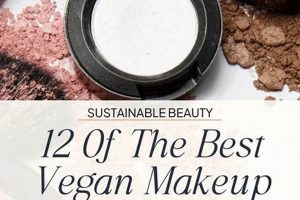Footwear designed for walking and hiking, crafted without the use of any animal-derived materials, falls under the category of plant-based outdoor shoes. Common examples include boots constructed from synthetic textiles, rubber, and plant-based alternatives like pineapple leaf fiber (Piatex) or mushroom leather (Mylo).
The increasing demand for ethically sourced and sustainable products has fueled interest in animal-free outdoor gear. Benefits include a reduced environmental impact compared to traditional leather production, the avoidance of animal cruelty, and often, comparable or superior performance characteristics in terms of weight, breathability, and water resistance. Historically, limited options were available, but advancements in material science have led to a wide array of high-quality, durable selections.
The subsequent sections will delve into critical considerations when selecting such footwear, examine specific models available in the market, and provide guidance on proper care and maintenance to ensure longevity and optimal performance during outdoor activities.
Essential Considerations for Acquisition
The selection of appropriate walking boots necessitates careful evaluation. Prioritization of factors such as material composition, construction techniques, and performance characteristics is paramount.
Tip 1: Prioritize Material Durability. Synthetic materials should exhibit high abrasion resistance to withstand rugged terrains. Reinforced stitching and robust construction are indicative of a longer lifespan.
Tip 2: Assess Waterproofing Capabilities. Adequate protection against moisture is crucial. Look for waterproof membranes and water-repellent treatments to maintain dryness in wet conditions. Consider boots with integrated gaiter compatibility for enhanced protection.
Tip 3: Evaluate Sole Traction and Support. The outsole should provide reliable grip on diverse surfaces. Deep lugs and a stable platform contribute to secure footing. Midsole cushioning should offer adequate support and impact absorption.
Tip 4: Examine Ankle Support and Fit. Proper ankle support reduces the risk of injury on uneven terrain. Ensure a snug but comfortable fit that allows for natural foot movement. Break in new boots gradually to minimize discomfort.
Tip 5: Consider Weight and Breathability. Lighter boots minimize fatigue during extended hikes. Breathable materials promote ventilation and reduce moisture buildup, enhancing comfort in warm weather. Balance weight reduction with necessary support and protection.
Tip 6: Research Brand Reputation and Reviews. Investigate established brands known for producing high-quality outdoor footwear. Consult user reviews to gain insights into real-world performance and durability.
Adhering to these guidelines will facilitate the selection of plant-based walking boots that provide optimal performance, durability, and comfort for various outdoor pursuits.
The subsequent sections will delve into specific models, care instructions, and the overall impact of selecting such footwear on environmental sustainability.
1. Material Sourcing
Material sourcing constitutes a foundational element in the production of plant-based walking boots. The origin and processing of materials directly impact the product’s environmental footprint, ethical implications, and performance characteristics. Unlike conventional walking boots that typically utilize leather derived from animal hides, plant-based alternatives rely on synthetic polymers, recycled textiles, or innovative bio-based materials. The selection of specific raw materials significantly influences the sustainability credentials of the final product. For instance, the use of recycled PET bottles as a primary component in synthetic uppers diverts waste from landfills and reduces the demand for virgin petroleum-based plastics. Similarly, employing natural rubber harvested from sustainably managed forests minimizes deforestation and promotes biodiversity.
The impact of material sourcing extends beyond environmental considerations to encompass ethical labor practices. Responsible manufacturers prioritize transparency in their supply chains, ensuring that materials are sourced from suppliers who adhere to fair labor standards and provide safe working conditions. This commitment to ethical sourcing mitigates the risk of contributing to human rights abuses within the global textile industry. Furthermore, the performance characteristics of plant-based walking boots are intrinsically linked to the properties of the selected materials. For example, the water resistance, breathability, and durability of the upper material directly affect the boot’s ability to protect the wearer’s feet in various weather conditions. The traction and abrasion resistance of the outsole material determine its performance on different types of terrain.
In conclusion, material sourcing is a crucial determinant of the overall value and sustainability of plant-based walking boots. By carefully selecting materials that are both environmentally responsible and ethically sourced, manufacturers can create footwear that aligns with the values of conscious consumers while delivering the performance and durability required for outdoor activities. The industry’s continued investment in research and development of innovative, sustainable materials will further enhance the appeal and viability of plant-based walking boots as a mainstream alternative to conventional leather options.
2. Sole Durability
Sole durability represents a critical performance characteristic of any walking boot, but its significance is amplified within the context of plant-based footwear. Traditional walking boots often rely on leather uppers paired with rubber outsoles. With plant-based alternatives, the entire construction must forgo animal products, necessitating careful selection of durable, non-animal-derived sole materials. Inadequate sole durability directly translates to a shortened lifespan for the boot, undermining its economic and environmental value. For instance, a sole that quickly delaminates from the upper or exhibits excessive wear after minimal use renders the boot unusable, requiring premature replacement. This increased frequency of replacement directly contradicts the sustainability goals often associated with selecting a plant-based alternative.
The challenge lies in identifying synthetic or plant-derived materials that can match the durability of traditional rubber compounds. Manufacturers often employ specialized rubber formulations incorporating high abrasion resistance and robust tread patterns to address this concern. Furthermore, the method of sole attachment, such as direct injection molding or adhesive bonding, significantly impacts its longevity. Boots featuring inferior bonding techniques are prone to premature separation, particularly under demanding conditions. Real-world examples highlight the importance of this factor: hikers traversing rocky terrain consistently report accelerated wear on boots with poorly constructed soles, regardless of the upper material’s integrity. Therefore, assessing sole construction and material composition becomes paramount when evaluating plant-based walking boot options.
Ultimately, the durability of the sole determines the long-term viability of plant-based walking boots. It directly impacts both the consumer’s investment and the environmental footprint of the product. While the upper materials may align with sustainable principles, a short-lived sole negates many of these benefits. Hence, prioritizing models with proven sole durability through rigorous testing and positive user feedback ensures that plant-based walking boots deliver both ethical sourcing and lasting performance. This emphasis on longevity fosters a more sustainable approach to outdoor gear consumption, reducing waste and promoting a more responsible interaction with the natural environment.
3. Water Resistance
Water resistance is a critical performance parameter in walking boots, irrespective of material composition. In the context of plant-based options, its importance is magnified due to the inherent properties of alternative materials often employed. The primary function of water resistance is to prevent external moisture from penetrating the boot’s interior, maintaining a dry environment for the wearer’s feet. Compromised water resistance leads to discomfort, increased risk of blisters, and accelerated heat loss, particularly in cold conditions. This necessitates a close examination of the waterproofing technologies integrated into plant-based walking boots.
The implementation of water resistance in footwear commonly involves a combination of tightly woven or non-woven fabrics and waterproof membranes. In plant-based walking boots, these membranes must, of course, be synthetic. These membranes, often constructed from materials like polyurethane (PU) or polytetrafluoroethylene (PTFE), possess microscopic pores that permit the passage of water vapor while blocking liquid water. The efficacy of these membranes is contingent on proper layering and seam sealing. Insufficient seam sealing allows water to infiltrate through stitching, bypassing the membrane’s intended barrier. A real-world example involves hikers encountering stream crossings or prolonged rainfall; boots with substandard water resistance quickly saturate, resulting in discomfort and potential hypothermia in colder climates. Moreover, repeated wetting and drying cycles can degrade the structural integrity of certain synthetic materials, further compromising water resistance over time. Some high-quality boots use Durable Water Repellent (DWR) treatments that cause water to bead up and roll off the surface. DWR coatings can wear off over time and require reapplying. The absence of proper coatings can lead to fabric saturation and reduced breathability, which increases moisture buildup inside the boot.
Therefore, when evaluating plant-based walking boots, water resistance should be a prioritized consideration. This assessment should extend beyond simply noting the presence of a waterproof membrane to include scrutinizing construction quality, seam sealing techniques, and the water repellency of the outer materials. Long-term performance and durability are directly linked to the effectiveness of the boot’s water resistance capabilities, ensuring comfort and safety in diverse outdoor conditions. Failure to adequately address this aspect undermines the utility of the boot, irrespective of its ethical sourcing.
4. Ankle Support
Ankle support constitutes a critical design element in walking boots, influencing stability and injury prevention, particularly on uneven terrains. Plant-based walking boots must offer comparable or superior ankle support to their traditional counterparts while adhering to animal-free material constraints. Inadequate ankle support increases the risk of sprains and strains, potentially sidelining hikers or walkers. Proper ankle support is achieved through a combination of boot height, stiffness of the upper material, and the lacing system’s configuration. The boot shaft extends above the ankle joint, providing resistance against lateral movement. Stiffer materials, often synthetic textiles or reinforced polymers in plant-based options, offer greater stability. A well-designed lacing system secures the foot and ankle within the boot, preventing excessive pronation or supination.
Real-world examples illustrate the significance of this feature. Hikers navigating rocky trails frequently encounter unstable footing. Boots with robust ankle support mitigate the impact of sudden twists and turns, reducing the likelihood of injury. Conversely, boots with flimsy or poorly designed ankle support mechanisms offer minimal protection, increasing vulnerability to ankle injuries. The construction of the boot influences ankle support, considering the integration of internal or external supports around the ankle area. High-quality plant-based boots incorporate these elements to ensure structural integrity and minimize the risk of ankle instability during strenuous activities. This is essential for maintaining balance and preventing falls on inclines or declines.
In summary, ankle support is an indispensable feature of effective walking boots. Plant-based options must prioritize this aspect through careful design and material selection. Understanding the mechanisms through which ankle support is achieved, and recognizing its real-world benefits in injury prevention, empowers informed purchasing decisions. Prioritizing models that offer adequate ankle support ensures both safety and performance on the trail, enabling users to pursue outdoor activities with confidence. The challenge lies in achieving this balance between support, flexibility, and the ethical material sourcing that defines these kinds of boots.
5. Footbed Comfort
Footbed comfort constitutes a critical factor in the overall performance and usability of walking boots, especially within the realm of plant-based options. Considering the absence of traditional leather components, the materials and construction techniques employed in footbeds directly influence foot health, fatigue levels, and the overall walking experience.
- Material Composition and Moisture Management
The composition of the footbed dictates its ability to manage moisture and maintain a comfortable microclimate within the boot. Materials like open-cell foams or synthetic textiles with moisture-wicking properties prevent the accumulation of sweat, reducing the risk of blisters and fungal infections. In contrast, footbeds constructed from less breathable materials contribute to moisture buildup, compromising comfort and potentially leading to skin irritation, especially during prolonged wear or in warm conditions. This is particularly relevant in plant-based walking boots where manufacturers are deliberately avoiding leather known for it’s natural breathability, and must focus on alternative advanced material science to replicate this benefit.
- Arch Support and Biomechanical Alignment
Appropriate arch support is crucial for maintaining proper biomechanical alignment of the foot and lower leg. A well-designed footbed provides support for the arch, preventing overpronation or supination, which can lead to discomfort, pain, and even long-term musculoskeletal issues. Plant-based walking boots should incorporate footbeds that offer adequate arch support based on individual foot type and gait patterns. Without sufficient support, the repetitive stress of walking can exacerbate existing foot problems and create new ones.
- Cushioning and Impact Absorption
The cushioning properties of the footbed play a vital role in absorbing impact forces generated during walking. Materials like EVA (ethylene-vinyl acetate) or polyurethane (PU) foams provide cushioning that reduces stress on joints and ligaments. Plant-based walking boots should feature footbeds with sufficient cushioning to minimize fatigue and prevent discomfort, especially during long-distance hikes or on hard surfaces. Inadequate cushioning can result in increased strain on the feet, knees, and back.
- Shape and Contour
The shape and contour of the footbed should conform to the natural anatomy of the foot. A well-contoured footbed provides uniform support and distributes pressure evenly across the foot’s surface. Plant-based walking boots should utilize footbeds that are ergonomically designed to accommodate the foot’s curves and prevent pressure points. Ill-fitting footbeds can cause localized discomfort, numbness, or even nerve compression.
These facets collectively underscore the significance of footbed comfort in plant-based walking boots. The selection of appropriate footbed materials, arch support features, cushioning properties, and ergonomic designs directly impacts the wearer’s experience. Manufacturers should prioritize footbed comfort alongside other performance attributes to create plant-based walking boots that promote foot health, reduce fatigue, and enhance the overall enjoyment of outdoor activities. Consumers should try on boots and, if possible, use them for a short walk to determine how footbed comfort feels.
6. Ethical Production
Ethical production constitutes a fundamental dimension of the plant-based walking boot industry, extending beyond mere material composition to encompass labor practices, environmental stewardship, and supply chain transparency. Its relevance stems from the growing consumer awareness of the social and ecological impacts associated with manufacturing processes. Products deemed “best” must therefore demonstrate adherence to rigorous ethical standards.
- Fair Labor Practices
Ensuring fair wages, safe working conditions, and the right to collective bargaining for all workers involved in the production process is paramount. This mitigates the risk of exploitation and promotes worker well-being. For instance, brands committed to ethical production often partner with factories that undergo independent audits to verify compliance with labor standards, such as those established by the Fair Labor Association. Lack of fair labor practices results in social exploitation which can lead to reputational damage for brands involved and perpetuates harmful labor patterns.
- Environmental Stewardship
Minimizing the environmental footprint of manufacturing operations is crucial. This involves implementing sustainable practices such as reducing water consumption, minimizing waste generation, and utilizing renewable energy sources. Companies pursuing ethical production often invest in technologies that reduce pollution and greenhouse gas emissions. Neglecting environmental stewardship contributes to ecological degradation and climate change, which is contrary to the values often associated with plant-based products.
- Supply Chain Transparency
Providing clear and accessible information about the sourcing of raw materials and the locations of manufacturing facilities fosters accountability and allows consumers to make informed purchasing decisions. Traceability systems enable companies to track the origin of components and ensure that they are not derived from unethical or unsustainable sources. Opaque supply chains create opportunities for exploitation and environmental damage to remain hidden from public scrutiny. Companies with ethical production values often embrace supply chain mapping to ensure the product is fully ethical at every stage.
- Waste Reduction and Circularity
Implementing strategies to minimize waste throughout the product lifecycle, including the use of recycled materials, designing for durability, and offering repair services, promotes resource efficiency and reduces landfill waste. Circular economy principles encourage the reuse and recycling of materials, extending their lifespan and reducing the need for virgin resources. Without waste reduction strategies, the environmental benefits of plant-based materials can be offset by inefficient production processes and product disposal practices.
These interconnected elements define the scope of ethical production within the context of plant-based walking boots. Brands that prioritize these principles not only contribute to a more just and sustainable world but also enhance their credibility and appeal to ethically conscious consumers. The best plant-based walking boots, therefore, embody a holistic commitment to ethical values, extending beyond vegan materials to encompass the entire production ecosystem.
Frequently Asked Questions
The subsequent section addresses common inquiries regarding plant-based walking boots, providing clear and concise answers to aid in informed decision-making.
Question 1: Are plant-based walking boots as durable as traditional leather boots?
Durability is contingent on material selection and construction techniques. High-quality synthetic materials, reinforced stitching, and robust sole attachments can yield comparable or superior durability to leather boots. Review product specifications and user feedback to ascertain the boot’s expected lifespan.
Question 2: Do plant-based walking boots offer sufficient water resistance?
Water resistance varies depending on the membrane technology and outer material properties. Waterproof membranes, seam sealing, and Durable Water Repellent (DWR) treatments enhance water resistance. Assess product descriptions for waterproofing certifications and user testimonials regarding performance in wet conditions.
Question 3: Can plant-based walking boots provide adequate ankle support?
Ankle support depends on boot height, upper material stiffness, and lacing system design. Taller boots with rigid uppers and secure lacing mechanisms offer greater ankle stability. Evaluate boot specifications and consider trying the boots on to ensure adequate support for the intended activity.
Question 4: Are plant-based walking boots suitable for all types of terrain?
Terrain suitability is determined by sole traction, lug pattern, and overall boot construction. Aggressive lug patterns provide better grip on loose or uneven surfaces. Select boots designed for the specific types of terrain encountered on planned hikes or walks.
Question 5: How does one properly care for plant-based walking boots?
Care instructions vary depending on the materials used. Generally, cleaning with mild soap and water, air drying away from direct heat, and reapplying DWR treatments as needed are recommended. Consult the manufacturer’s guidelines for specific care recommendations.
Question 6: Are plant-based walking boots more environmentally friendly than leather boots?
The environmental impact depends on the sourcing and manufacturing processes of both types of boots. Plant-based options avoid the ethical and environmental concerns associated with leather production. Opting for boots made from recycled materials or produced in factories with sustainable practices further reduces their environmental footprint.
In summary, plant-based walking boots can offer comparable performance, durability, and ethical advantages when carefully selected and properly maintained. Scrutinizing product specifications, user reviews, and manufacturer information is crucial to making an informed decision.
The subsequent section will present specific plant-based walking boot models available on the market, highlighting their key features and intended use cases.
Concluding Remarks
The examination of “best vegan walking boots” reveals a complex interplay of material science, ethical considerations, and performance demands. Successful designs prioritize durability, water resistance, and ankle support through innovative material sourcing and construction techniques. The conscientious consumer must weigh these factors, recognizing that a truly superior product integrates environmental responsibility with functional excellence.
The market’s evolution necessitates continued research and development, striving for plant-based alternatives that not only match but surpass the performance of traditional leather footwear. Sustained progress hinges on transparent supply chains, fair labor practices, and a commitment to minimizing environmental impact. Ultimately, the selection of walking boots represents a choice that extends beyond personal comfort, reflecting a commitment to ethical consumption and a sustainable future.







